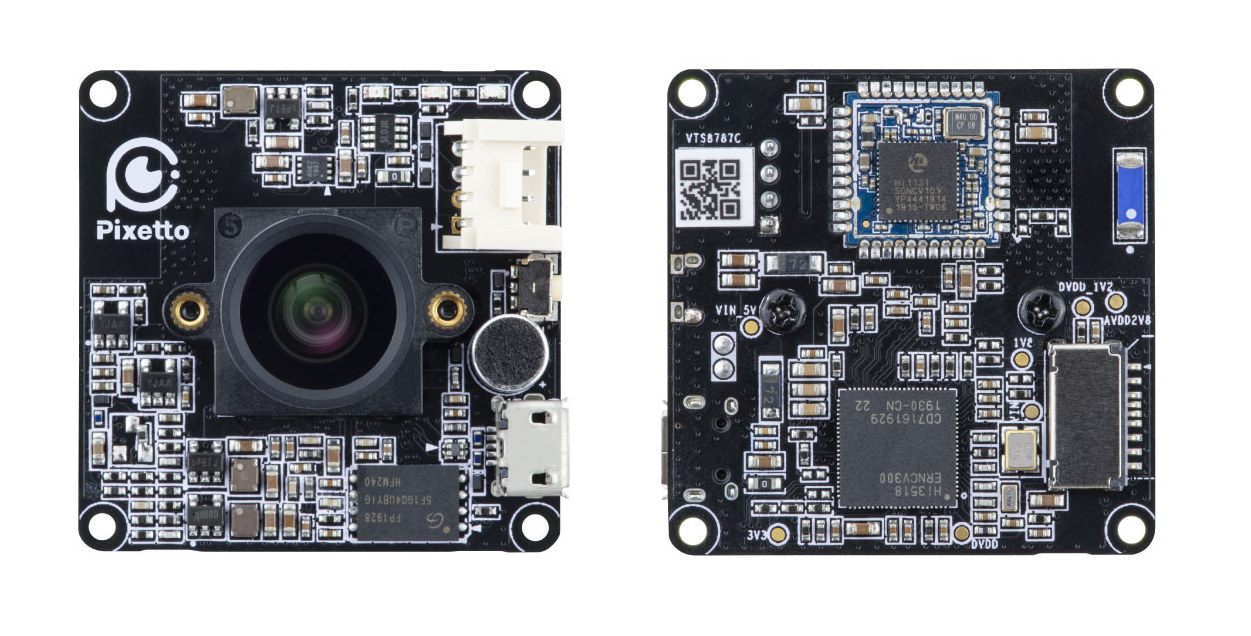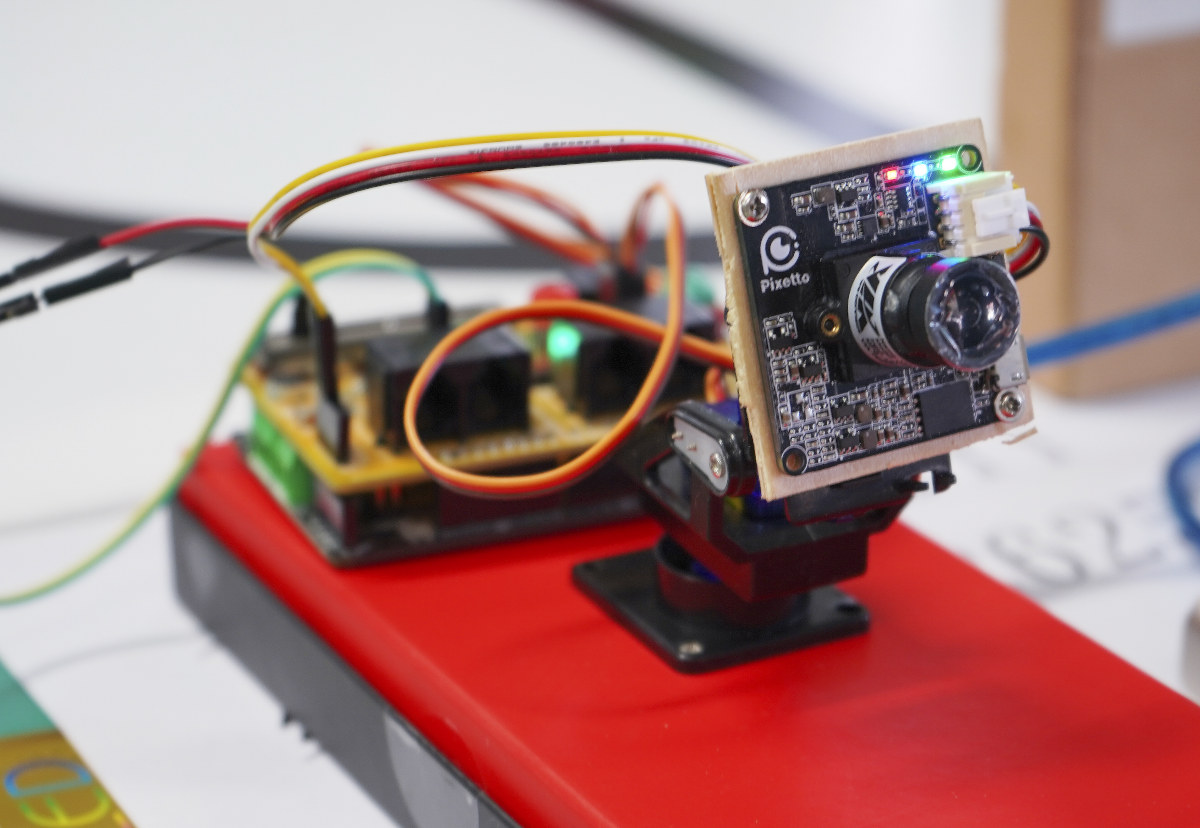VIA Technologies has launched the VIA Pixetto vision sensor aims to teach artificial intelligence (AI) and machine learning (ML) to students aged twelve and above.
The Linux board features an Hisilicon Hi3518E V300 Cortex-A7 HD camera SoC combined with 64MB RAM, 128MB SPI flash, a MicroSD slot, as well as GalaxyCore GC2053 2M CMOS sensor offering 1920 x 1080 resolution and a 130° field of view.
VIA Pixetto hardware specifications:
- SoC – Hisilicon Hi3518E V300 Cortex-A7 HD camera SoC @ 900 MHz with H.264, H.265, MJPEG/JPEG encoder
- System Memory – 64MB DDR, MicroSD card slot
- Storage – 128MB SPI flash
- Camera – GalaxyCore GC2053 2M CMOS sensor with 1920 x 1080 resolution, 130° FoV
- Audio – Microphone
- USB – 1x Micro USB 2.0 port
- Connectivity – WiFi 4 via Hisilicon Hi1131 low-power Wi-Fi chip and ceramic antenna
- Expansion – Grove connector
- Misc – 3x LEDs (Power, OS boot, active status), 1x reset button
- Power Supply
- 5V/500mA via Micro USB port
- 5V/300mA via Grove connector
- Dimensions – 38 x 38 mm
The datasheet also mentions an “Integrated HDMI 2.0 transmitter supports 4K display”, but this must be an error since I can’t find any related connector, and there’s no mention of HDMI in the processor product’s brief.
 Beyond hardware, it’s software that makes the board stands out, as VIA has developed tools to make it easy for students to understand the basic principles and technologies underpinning AI and ML and apply them in AI vision, maker, and robotics projects.
Beyond hardware, it’s software that makes the board stands out, as VIA has developed tools to make it easy for students to understand the basic principles and technologies underpinning AI and ML and apply them in AI vision, maker, and robotics projects.
Students will be first asked to download VIA Pixetto Studio software packages, compatible with Windows 7 to 10, and contains 6 different applications:
- Pixetto Utility is used to configure the VIA Pixetto vision sensor when training it to perform Color Detection, Color Label Detection, Shape Detection, Sphere Detection, Keypoint Template Matching, Apriltag (16H5), Cloud Computing and Lane Detection
- Pixetto Editor is a programming application for Arduino IDE users based on the Blockly framework.
- Pixetto Junior is a programming application for Arduino IDE users based on the Scratch platform.
- Pixetto Link creates a bridge connecting the VIA Pixetto vision sensor and Machine Learning Accelerator web page.
- Pixetto Serial Tool is used for debugging
- Pixetto Launcher gives access to online training services for the VIA Pixetto vision sensor.
The board also supports Python and TensorFlow Lite for more advanced students, which the company claims make it compatible with Arduino, Raspberry Pi, and micro:bit projects. You’ll find all resources to get started on Pixetto.ai website.
VIA Pixetto can be purchased for $85 plus shipping on VIA online store.
Via LinuxGizmos

Jean-Luc started CNX Software in 2010 as a part-time endeavor, before quitting his job as a software engineering manager, and starting to write daily news, and reviews full time later in 2011.
Support CNX Software! Donate via cryptocurrencies, become a Patron on Patreon, or purchase goods on Amazon or Aliexpress. We also use affiliate links in articles to earn commissions if you make a purchase after clicking on those links.






with all things going on at Huawei(where Hi3518 is made) and who happens to be the largest surveillance camera chip provider on earth(after beating down TI easily), I’m unsure if I still should buy boards with chips from hisilicon(semiconductor for huawei) these days.
Heh, looked at the Hi3516 camera a couple of years ago with a view to getting rid of its ONVIF cruft and using the h.265 encoder more directly…VIA has had much the same idea, just with an AI angle, it seems…I wonder if the h.265 encoder is more directly accessible in the VIA Hi3518 here (docs does not really say). The windows apps and their “record video” buttons from VIA are about as useful as the ONVIF client software from that perspective 😐 …kudos to VIA nonetheless
These chips have been on taobao for $1.8 for a while and the SDK for them is pretty clean. I hadn’t seen them actually used in something until this though.
I wonder if that hisilicon wifi chip is another license of the same IP that’s in the xr819.
A few new versions of that have appeared recently.
HI3518 is most common camera chip in the world. It used in millions and millions of cameras. There are many variants on it Hi3518a, hi3518e, hi3518v200, etc. I saw video a few years ago of a plant in China running four SMD lines 24/7 making hi3518e modules for internal Chinese market.
Note this is using Hi3518V300 which is most recent version of the chip.
Looks like all of the SDKs are here:
https://dl.openipc.org/SDK/HiSilicon/
The older chips were ARM9. This one is interesting because it’s Cortex A7.
the issue is, can they keep providing the chips in the future when TSMC and the license to design chips are no longer possible. might be time for TI to get back to surveillance chips, e.g. ti369,ti370,etc
Has Hisilicon been cut off? Current news articles say no.
I thought it would be cut off too, but it’s not, at least based on the list from the government:
Huawei Cloud Computing Technology; Huawei Cloud Beijing; Huawei Cloud Dalian; Huawei Cloud Guangzhou; Huawei Cloud Guiyang; Huawei Cloud Hong Kong; Huawei Cloud Shanghai; Huawei Cloud Shenzhen; Huawei OpenLab Suzhou; Wulanchabu Huawei Cloud Computing Technology; Huawei Cloud Argentina; Huawei Cloud Brazil; Huawei Cloud Chile; Huawei OpenLab Cairo; Huawei Cloud France; Huawei OpenLab Paris; Huawei Cloud Berlin; Huawei OpenLab Munich; Huawei Technologies Dusseldorf GmbH; Huawei OpenLab Delhi; Toga Networks; Huawei Cloud Mexico; Huawei OpenLab Mexico City; Huawei Technologies Morocco; Huawei Cloud Netherlands; Huawei Cloud Peru; Huawei Cloud Russia; Huawei OpenLab Moscow; Huawei Cloud Singapore; Huawei OpenLab Singapore; Huawei Cloud South Africa; Huawei OpenLab Johannesburg; Huawei Cloud Switzerland; Huawei Cloud Thailand; Huawei OpenLab Bangkok; Huawei OpenLab Istanbul; Huawei OpenLab Dubai; and Huawei Technologies R&D UK
But then if it’s not in the list, I don’t see why Huawei could not get all of their chips via Hisilicon.
But then earlier press release (May 2020), the commerce department did mention Hisilicon: